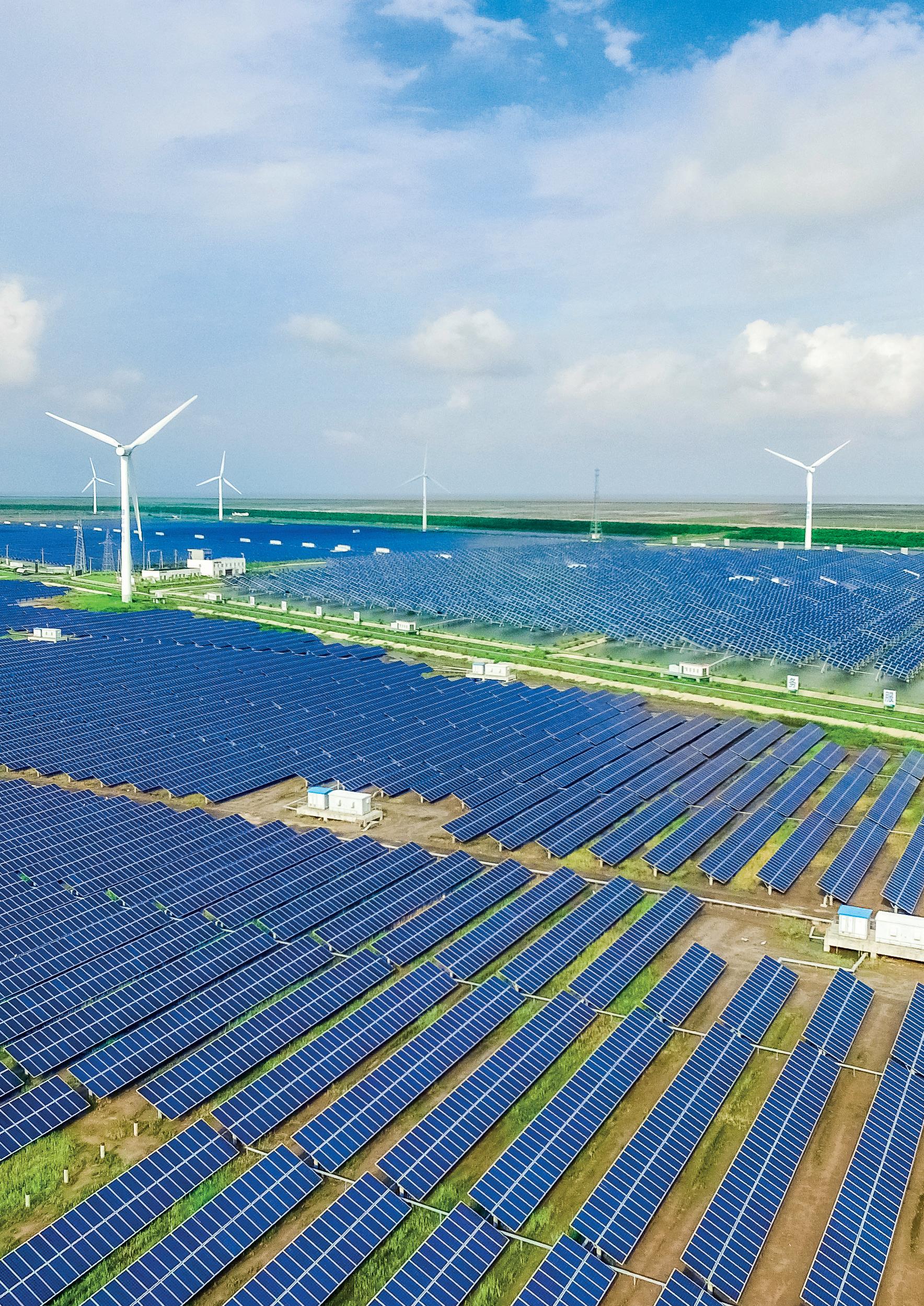Assessing the social and economic impacts of environmental policies
Key findings from OECD research

Policymakers face the challenge of supporting both inclusive economic development and a healthy environment. To respond to this challenge, regulators need tools and insights to assess the consequences of environmental policies on the economy and social outcomes. This document highlights insights from recent OECD work on the interlinkages between environmental policies and socio-economic goals as well as key policy considerations.


Table
contents 1 THE IMPORTANCE OF ASSESSING THE SOCIAL AND ECONOMIC IMPACTS OF ENVIRONMENTAL POLICIES ���������� 2 2 ASSESSING THE ECONOMIC IMPACTS OF ENVIRONMENTAL POLICIES 4 The benefits of air pollution reduction 4 The effect of clean innovation on firms’ economic performance 6 The effects of climate policies on clean innovation and economic performance 8 3 ASSESSING THE EMPLOYMENT IMPACTS OF ENVIRONMENTAL POLICIES 10 The employment impacts of higher energy prices 10 The impact of fossil fuel subsidies removal on employment 12 The work summarised in this document was all produced with the financial assistance of the European Union. This does not cover all OECD work on this topic. For more information, see back cover. ©
of
Shutterstock/Fanjianhua
The importance of assessing the social and economic impacts of environmental policies
Policymakers face the challenge of supporting both inclusive and sustainable economic development and a healthy environment.
While the most desirable policy outcome is one that achieves the greatest environmental benefits while also advancing socio-economic goals, it is important for policymakers to fully understand the possible trade-offs between these objectives. A better understanding of the broader impacts of environmental policies is crucial to mitigate their adverse effects on competing goals, especially as countries are faced with the arduous task of responding to mounting environmental challenges in economically turbulent times.
Governments are under pressure to scale up and accelerate their ambition on climate and environmental goals.
But in taking such action forward, they have to carefully navigate a number of headwinds. These include the long-term impacts of the COVID-19 pandemic on both the economy and society, cost-of-living crisis, political tensions and geopolitical crises such as the Russian invasion of-Ukraine. Low-income people and the poorest economies are the hardest hit, primarily due to the steep increases in the price of energy and food.
The level of environmental policy stringency can have an impact on a variety of policy outcomes (Figure 1). Empirical research is crucial to shed light on these interlinkages.
Previous research has shown that more stringent environmental policy has achieved significant environmental benefits with little aggregate effect on economic performance. However, localised effects may generate winners and losers, with significant losses for certain sectors, firms or individuals and benefits for others. Nonetheless, at present, the empirical evidence on these distributional aspects is still scarce, despite its crucial role in supporting good policy design.
More than ever, regulators need better tools and insights to assess the consequences of environmental policies on the economy and on social outcomes.
This document highlights insights from recent OECD work on the interlinkages between environmental policies and socio-economic goals as well as key policy considerations emerging from this work. The objective is to provide policy makers with clear guidance as they pursue the twin objectives of supporting inclusive and sustainable economic development and a healthier environment.
The document is organised in two main sections. The first section looks at recent OECD work assessing the economic impacts of environmental policies, the second highlights empirical research on the effects of tighter environmental policies on employment.
2 Assessing the social and economic impacts of environmental policies
1
Environmental performance

Environmental
Green innovation
Employment
Economic performance
3
Figure 1. Investigating the impacts of environmental policy on socio-economic goals and the environment: a roadmap�
policy stringency
? ? ? ? ?
© iStock
/ Charlie Chesvick
2
Assessing the economic impacts of environmental policies
The benefits of air pollution reduction
Air pollution is widely recognised to be a major threat to human health:
> 1 in 10 people live in areas where air quality is below recommended levels.
> 1 in 8 deaths globally every year are caused by air pollution.

> Air pollution dominates all other major avoidable causes of death including tobacco smoking, alcohol use and road accidents.
> Air pollution also has significant negative impacts on individuals’ cognitive capabilities.
The negative consequences of air pollution have led to the introduction of increasingly stringent environmental regulations, but controversy remains over their appropriate design and stringency level. Imposing environmental regulations is typically seen as a tradeoff between generating benefits to health and the environment and imposing costs on the economy. However, this ignores that health benefits can lead to improved productivity, which can itself translate into greater economic output.
“ The economic cost of air pollution: Evidence from Europe” assesses the impact of air pollution exposure on economic output at the aggregate level.
The study finds that:
• Air pollution reduction positively and substantially affects economic activity.
• Most of the impact on GDP is due to increases in output per worker, which can occur through lower absenteeism at work or improved labour productivity.
4 Assessing the social and economic impacts of environmental policies
POLICY IMPLICATIONS
Air pollution control policies may impact positively and substantially economic growth. This reinforces the case for integrating green considerations into mainstream economic policy-making.
More stringent air quality regulations can be justified based on economic grounds. This is because the economic benefits from pollution reduction far outweigh abatement costs.
In the context of the European Union, since Eastern European countries face higher pollution levels on average, air pollution control policies could significantly contribute to economic convergence between Eastern and Western Europe, and could be seen as useful complements to structural policies aiming at fostering economic growth.



5
© iStock / Gemini Pro Studio © iStock / NuttKomo
The effect of clean innovation on firms’ economic performance
Innovation is critical for a transition towards a low-carbon economy. While there is ample empirical evidence that environmental regulation spurs investment in green technologies, the economic consequences for firms investing in green innovation, and therefore their incentives to innovate, are less well understood.
Determining the private returns to firms’ green innovation is important because they can provide incentives to innovate in addition to public policies like R&D subsidies. One hypothesis is that innovations induced by stringent environmental policy increase productivity and profitability by decreasing firms’ inefficiencies. However, the results from empirical studies are mixed. While some studies find a positive effect of some types of green innovation on profitability and productivity, others find no effect. An important dimension missing from these studies is that it might take time for innovation to lead to better economic performance.
“The economic benefits of early green innovation: evidence from the automotive sector” investigates empirically the impact of green innovation on car manufacturers’ market share when fuel prices increase. In particular, it estimates the return to innovation in technologies that reduce vehicle fossil fuel use per distance travelled, or bypass fossil fuel use, in the years after knowledge is accumulated. The analysis estimates how these returns depend on fuel price signals. The analysis employs data on market shares obtained from national car manufacturer associations. The data include firms covering over 95% of the market across eight countries (France, Germany, Italy, Japan, Poland, Portugal, Spain, and the United States) over the period 2005-2021.
The study finds that:
• When vehicle fuel prices increase, firms having previously invested in patents related to electric and hybrid vehicles or fuel efficiency experience an increase in their market share.

• This effect is large and takes place between 8 and 15 years after the patent stock is accumulated for patents related to fuel efficiency and between 7 and 8 years for patents related to electric and hybrid vehicles.
• In contexts where fuel price salience (attention to price) is high, price increases generate larger and earlier competitiveness returns for firms having previously invested in fuel-efficiency technologies.
POLICY IMPLICATIONS
Innovation in green technologies can lead to economic benefits for cleaner firms in the long run if price signals are strong enough, but evaluating these benefits requires looking at long timespans of several years to a decade.
Policies that increase price visibility can lead to a larger adoption of cleaner cars and larger rewards for greener firms.
6 Assessing the social and economic impacts of environmental policies
© iStock / M. Mphoto
PANEL A Effects of innovating in electric and hybrid (clean) car technologies.
Years between the share of clean patent stock and increase in fuel prices
PANEL B Effects of innovating in fuel efficient (grey) car technologies.
Years between the share of grey patent stock and increase in fuel prices
Source: Agnelli, Costa, Dussaux (2023), “The economic benefits of early green innovation: evidence from the automotive sector”.
7
-0,60 -0,40 -0,20 0,00 0,20 0,40 0,60 1 2 3 4 5 6 7 8 9 10 11 12 13 14 15 16 17 18 19 20 Marginal effect of a 1 pp increase in the share of clean patent stock on market share (in pp)
Figure 2. Marginal effect of past innovation on firm market share for median fuel prices across years�
1 2 3 4 5 6 7 8 9 10 11 12 13 14 15 16 17 18 19 20
-0,60 -0,40 -0,20 0,00 0,20 0,40 0,60
effect of a 1 pp increase in the share of
patent stock
market share (in pp)
Marginal
grey
on
The effects of climate policies on clean innovation and economic performance
Innovation in clean technologies is necessary to achieve the required emission reductions to make the low-carbon transition compatible with sustained economic growth. However, patent filings in low-carbon technologies have declined over the past years, raising concerns that innovation in cleaner technologies is slowing down at the time they are the most needed. This may suggest that current environmental policies are not providing enough incentives for firms to innovate in low-carbon technologies and need to be reinforced
However, environmental policies such as carbon pricing policies are often difficult to implement due to concerns that they may harm the productivity of firms or destroy jobs. Thus, an important question from a policy perspective is whether providing incentives to firms to innovate in low-carbon technologies through environmental regulation is harmful to economic performance.
“The effect of climate policy on innovation and economic performance along the supply chain” empirically assesses the effect of climate policy stringency on innovation and economic performance, both directly on regulated sectors and indirectly through supply chain relationships. The analysis is based on a combination of global firm-level and sector-level data combined with input-output tables, data on climate policy stringency and data on embodied CO2 emissions in international trade, covering 19 countries globally and the period from 1990 to 2015.
The study finds that:
• Climate policies are effective at inducing green innovation in directly regulated sectors, while they do not induce significant innovation along the supply chain.
• There is no evidence that climate policies – through the channel of clean innovation – either harm or improve the economic performance of directly regulated firms, in terms of productivity or value added.
POLICY IMPLICATIONS
Climate policies can be effective at boosting the pace of green innovation in the regulated sectors.
Relying on indirect effects by regulating up- or downstream sectors might not induce large additional green innovation along the value chain.
Past climate policies have not been major burdens on firms’ competitiveness.

8 Assessing the social and economic impacts of environmental policies

9 © iStock / GC
Shutter
Assessing the employment impacts of environmental policies
The employment impacts of environmental policies
Employment is perhaps the most important concern for policy makers when enacting climate policies, notably because employment impacts can be decisive in determining their political acceptability. However, evidence on the impact of environmental policies on employment is limited.
“The effect of energy prices and environmental policy stringency on manufacturing employment in OECD countries” empirically assesses the impact of increases in energy prices (a proxy for more stringent climate policies) and environmental policy stringency on manufacturing employment in OECD countries over the period 2000-2014.
The study finds that:
• In the manufacturing sector, higher energy prices and environmental policy stringency lead to a small decrease of total employment.
• Energy intensive sectors are most affected, while no change in employment is observed for less energy-intensive sectors.
• Even in highly energy-intensive sectors the effect is relatively small: a 10% increase in the price of energy prices reduces employment in the iron and steel sector by 2% in the short run.
• Higher energy prices increase the probability that firms exit the market, but they also have a positive effect on the employment level of surviving firms: a 10% increase in energy prices would increase employment of the average surviving firm by 0.7%.
POLICY IMPLICATIONS
Imposing stricter environmental policies implies transition costs in the short run as some workers are forced to move away from affected firms and sectors. It is crucial that policymakers mitigate the social impacts for affected workers.
Even if job losses are likely to occur – especially in more energyintensive sectors – they are unlikely to be permanent as laid-off workers may ultimately find other jobs.
Transition costs are typically highly localised in regions specialised in polluting activities and they can therefore translate into potentially significant regional effects and thus political costs.

10 Assessing the social and economic impacts of environmental policies
3
Note: Vertical bars represent 90% confidence intervals.
Source: Dechezleprêtre, A., D. Nachtigall and B. Stadler (2020), “The effect of energy prices and environmental policy stringency on manufacturing employment in OECD countries: Sector- and firm-level evidence”.

11
-0,4 -0,3 -0,2 -0,1 0 0,1 0,2 Effect of energy price index on employment by sector IronandsteelTransportequipment ChemicalandPetrochemicalNon-ferrousmetalsNon-metallicmineralsTextileandleatherWoodandwoodproducts MachineryOtherManufacturingFoodandtobaccoPaper,pulpandprint
Figure 3. Employment effects of higher energy prices across sectors�
© iStock / Hispanolistic
The impact of fossil fuel subsidies removal on employment

One of the major concerns amongst developing countries is that the phasing out of fossil fuel subsidies might lead to employment and income losses because they increase the cost of energy across all end users. However, little is known about how firms actually respond to energy price increases in the developing world.
“Assessing the impact of energy prices on plant-level environmental and economic performance” exploits geographically-based variations in energy price to identify the effect of energy price shocks on plant level environmental and economic performance. The study analyses the impact of these energy price increases induced by Indonesia’s fossil fuel subsidy reforms on plant-level economic and environmental performance.
The study finds that:
• An increase in energy prices due to a reduction in fossil fuel subsidy has large environmental benefits, while generating small adverse impact.
• A 10% increase in energy prices causes a reduction in energy use by 5.2% and a reduction in CO2 emissions by 5.8% on average.
• More energy-intensive sectors respond more to the shocks caused by energy price increases through reduced energy use.
• Energy price increases raise the probability of plant exit and reduce employment of large and energy intensive plants but the estimated effect on employment is very small (-0.2% for a 10% increase in energy prices).
• Energy price changes have no significant influence on net job creation at the industry level, suggesting that jobs are not lost but reallocated from energy inefficient to energyefficient firms.
12 Assessing the social and economic impacts of environmental policies
Note: The figure presents the parameter estimates from regressing the log-transformed employment (no. of workers) on the instrumented log-transformed energy price at the 2-digit sector level. Each point is weighted by the sum of total output (in ‘000 IDR) to reflect relative contribution to the entire industry. Sector 12 (Tobacco manufacturing) has been dropped to get better illustration. Vertical green bars are 90% confidence intervals.
Source: Brucal, A. and A. Dechezleprêtre (2021), “Assessing the impact of energy prices on plant-level environmental and economic performance: Evidence from Indonesian manufacturers”.
POLICY IMPLICATIONS
Environmental fiscal reforms in an emerging economy targeting the price of energy faced by firms would have large environmental benefits while not inducing employment losses.
However, phasing out fossil fuel likely generates employment reallocation across firms within sectors. Therefore, environmental fiscal reforms should be complemented by policies that accompany laid off workers and ease job reallocation.

13
Parameter Estimate; 95% CI -1 0 1 2 -10 -9.5 -9 -8.5 -8 Computer Chemical Metal Goods Beverage Electrical Printing Non-metal Installation Paper Industrial Base Metal Equipment Food Textile Furniture Others Transport Wood Average log (Energy Intensity)
Figure 4. Employment effects of higher energy prices across sectors�
© iStock / Bilanol
OECD work on social and economic outcomes of environmental policies
DEDICATED STUDIES
• Agnelli, A., H. Costa and D. Dussaux (2023), “The economic benefits of early green innovation: Evidence from the automotive sector”.OECD Environment Working Papers, No. 209, OECD Publishing, Paris, https://doi.org/10.1787/c13d5d61-en
• Brucal, A. and A. Dechezleprêtre (2021), “Assessing the impact of energy prices on plant-level environmental and economic performance: Evidence from Indonesian manufacturers”, OECD Environment Working Papers, No. 170, OECD Publishing, Paris, https://doi.org/10.1787/9ec54222-en
• Dechezleprêtre, A. and T. Kruse (2022), “The effect of climate policy on innovation and economic performance along the supply chain: A firm- and sector-level analysis”, OECD Environment Working Papers, No. 189, OECD Publishing, Paris, https://doi. org/10.1787/3569283a-en
• Dechezleprêtre, A., D. Nachtigall and F. Venmans (2018), “The joint impact of the European Union emissions trading system on carbon emissions and economic performance” , OECD Economics Department Working Papers, No. 1515, OECD Publishing, Paris, https://doi. org/10.1787/4819b016-en
• Dechezleprêtre, A., D. Nachtigall and B. Stadler (2020), “The effect of energy prices and environmental policy stringency on manufacturing employment in OECD countries: Sector- and firm-level evidence”, OECD Economics Department Working Papers, No. 1625, OECD Publishing, Paris, https://doi.org/10.1787/899eb13f-en
• Dechezleprêtre, A., N. Rivers and B. Stadler (2019), “The economic cost of air pollution: Evidence from Europe”, OECD Economics Department Working Papers, No. 1584, OECD Publishing, Paris, https://doi.org/10.1787/56119490-en
• Dussaux, D. (2020), “The joint effects of energy prices and carbon taxes on environmental and economic performance: Evidence from the French manufacturing sector”, OECD Environment Working Papers, No. 154, OECD Publishing, Paris, https://doi. org/10.1787/b84b1b7d-en
• OECD (2021), “Assessing the Economic Impacts of Environmental Policies: Evidence from a Decade of OECD Research”, OECD Publishing, Paris, https://doi.org/10.1787/ bf2fb156-en
• Vona, F. (2021), “Managing the distributional effects of environmental and climate policies: The narrow path for a triple dividend”, OECD Environment Working Papers, No. 188, OECD Publishing, Paris, https://doi.org/10.1787/361126bd-en
WORKSHOPS
• Pre-conference Workshop: The Economic Impacts of Air Pollution and the Implications for Policy
• Expert Workshop on Environmental Policies: Social and Economic Outcomes

Contact:
Shardul Agrawala
Head of Environment and Economy Integration Division, Environment Directorate, OECD
Shardul.Agrawala@oecd.org
https://www.oecd.org/environment
© OECD Environment Directorate, 2022.
14 Assessing the social and economic impacts of environmental policies
Graphic design: MH DESIGN / Maro Haas –Cover photo: © shutterstock / Sonpichit Salangsing


















